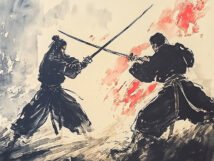Haedong Kumdo and Kendo have a long-standing rivalry rooted in tradition, culture, and authenticity debates in martial arts.
Key Takeaways 📝
- The rivalry between Haedong Kumdo and Kendo highlights deep-rooted cultural and historical debates, showcasing the ongoing tension between traditional values and modern interpretations in martial arts.
- A significant court ruling emphasized Haedong Kumdo's modern foundations, challenging the narrative that it is a direct descendant of ancient Korean practices.
- Haedong Kumdo practitioners assert their art's superiority by critiquing Kendo's safety protocols, positioning their techniques as more practical for real combat situations.
- Both martial arts have adapted over time; the Korean Kendo Association has incorporated real sword techniques while Haedong Kumdo has sought to appeal to younger audiences.
- The evolving dialogue between these two disciplines underscores the importance of preserving cultural heritage while embracing innovation in martial arts training.
The martial arts world is steeped in tradition, discipline, and occasionally, intense rivalries. One such rivalry that has been prominent since the late 1980s is between Haedong Kumdo and Kendo—two martial arts centered around swordsmanship but rooted in different cultural backgrounds. As Haedong Kumdo gained prominence, it encountered opposition from the established Korean Kendo Association, resulting in a series of controversies that continue to fuel discussions among practitioners and enthusiasts.
The Rise of Haedong Kumdo
Haedong Kumdo emerged as a significant martial art in the late 1980s. Its ascent was marked by conflict, particularly with the Korean Kendo Association, which had been the longstanding representative of Kendo, a Japanese martial art, in Korea. The tension peaked when the association accused Nahan-il, a notable figure in Haedong Kumdo, of falsely claiming a high rank and misusing Kendo terminology. Nahan-il defended his credentials in Haedong Kumdo, leading to the case's dismissal without charges.
The Martial Art “Do” Phenomenon
The convention of appending "do," meaning "way" or "path," to martial arts names began in Japan with Jigoro Kano's judo in the early 20th century. Kendo, or "way of the sword," follows this tradition. Despite Kendo being recognized as a proper noun, courts sided with Nahan-il due to the generic use of "Kendo" in Korea, which blurred lines between a specific martial art and a general term for swordsmanship.
Haedong Kumdo’s Critique of Kendo
Practitioners of Haedong Kumdo often critique Kendo, not just due to rivalry, but to assert their unique identity within the martial arts community. Criticisms typically focus on three themes: authenticity, practicality, and technique.
Authenticity Controversy
The authenticity of Kendo is a major contention point. Advocates of Haedong Kumdo claim Kendo was developed by the Japanese military, historically seen as oppressors of Korean independence forces. They argue that Haedong Kumdo is rooted in the Goguryeo period traditions of Korea, enhancing its prestige during a time of heightened nationalism. However, a court ruling in the 2000s revealed Haedong Kumdo as a modern creation linked to more recent schools.
Practicality Arguments
Haedong Kumdo practitioners argue their martial art is more practical, focusing on training with real swords and targeting unrestricted areas. Kendo, in contrast, uses bamboo swords and protective gear, with specific target areas for strikes. While Kendo proponents emphasize precision and skill, Haedong Kumdo dismisses these points as impractical limitations.Despite these debates, both martial arts have evolved. Some Haedong Kumdo schools adopted practices similar to Kendo, reflecting a blending of techniques aimed at improving training safety and practicality.
Slashing Controversy
Haedong Kumdo's focus on slashing techniques also sparks debate. These techniques, often demonstrated in public performances, are said to be adapted from Japanese styles like Nakamura-ryu. Critics claim Haedong Kumdo's emphasis on performance detracts from its martial authenticity, suggesting it has veered into dramatics over martial roots.
The Evolution of Kendo and Haedong Kumdo
In response to criticisms, the Korean Kendo Association has integrated real sword techniques, recognizing their historical and practical importance. Meanwhile, Haedong Kumdo has faced internal challenges, such as splits and financial issues. As of 2024, it markets itself as a modern, creative martial art, appealing to younger audiences much like taekwondo.
A New Era for Martial Arts
The ongoing dialogue between Haedong Kumdo and Kendo reflects broader themes in martial arts, such as balancing tradition with innovation and authenticity with adaptation. As practitioners refine their arts, they contribute to the rich cultural tapestry of martial arts evolution.This revised document organizes the content with clear hierarchical headings and removes any bold text or outlines, offering a structured and comprehensive look at the intriguing relationship between Haedong Kumdo and Kendo.
A Historical Lens
To truly understand the clash between Haedong Kumdo and Kendo, it is essential to view it through a historical perspective. Kendo, deeply rooted in the samurai traditions of Japan, signifies a long-standing practice that emphasizes discipline, respect, and the cultivation of one's spirit through rigorous training. Haedong Kumdo, in contrast, although a more recent development, claims a connection to Korea's Goguryeo period, invoking a sense of national pride and cultural heritage. This narrative, while contested, has served to galvanize support and differentiate Haedong Kumdo as a distinctly Korean martial art.
Cultural Significance
The cultural significance of both martial arts transcends their technical aspects. Kendo, being inherently Japanese, carries the weight of Japan's rich history and cultural heritage. Haedong Kumdo, although modern in its creation, taps into a historical narrative that resonates with Korean nationalism. This dynamic interplay of cultural identity and martial practice underscores the deeper societal narratives that martial arts can embody, serving not just as physical disciplines but as vessels of cultural expression and pride.
A Path Forward
Looking ahead, the relationship between Haedong Kumdo and Kendo offers insightful lessons about cultural integrity, historical accuracy, and mutual respect. In a world where globalization can often blur cultural distinctions, these martial arts highlight the importance of preserving tradition while embracing innovation. The journey of Haedong Kumdo and Kendo is ongoing. As both martial arts continue to evolve and adapt, they provide a fascinating glimpse into the dynamic world of martial arts—a domain where history and modernity intersect and cultural pride drives a pursuit of excellence that transcends generations. Whether one is a practitioner, a historian, or an enthusiast, the story of Haedong Kumdo and Kendo remains a captivating chapter in the ever-evolving narrative of martial arts, reflecting broader themes of cultural exchange and evolution.
Reference: Namu Wiki
Namu Kiwi is a comprehensive online platform that bears resemblance to Wikipedia, specifically tailored for users in Korea. This website serves as a valuable resource where individuals can explore a wide array of information related to Kumdo and Kendo, two traditional martial arts that have garnered significant interest and participation. Our mission is to collect, curate, and disseminate the latest news and updates concerning these disciplines, ensuring that our audience remains well-informed.
However, it is important to acknowledge that some of the information presented on our site may be the subject of ongoing debates and discussions within the community. As representatives of USHRK, we want to clarify that we do not align ourselves with any particular viewpoint or stance regarding these matters. Instead, our primary objective is to serve as a neutral platform where news and information can be shared freely and fairly. We believe in fostering an environment where all voices can be heard, allowing for an informed and balanced dialogue among practitioners and enthusiasts alike.














